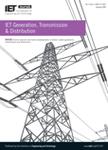版权所有:内蒙古大学图书馆 技术提供:维普资讯• 智图
内蒙古自治区呼和浩特市赛罕区大学西街235号 邮编: 010021

作者机构:Iran Univ Sci & Technol Sch Elect Engn Ctr Excellence Power Syst Automat & Operat Tehran *** Iran Tarbiat Modares Univ Sch Elect & Comp Engn Tehran Iran
出 版 物:《IET GENERATION TRANSMISSION & DISTRIBUTION》 (IET Gener. Transm. Distrib.)
年 卷 期:2022年第16卷第19期
页 面:3966-4006页
核心收录:
主 题:photovoltaic cells transmission system expansion planning cooling energy systems optimisation distribution system operators absorption chillers energy hubs cogeneration wind turbines power transmission planning optimization approach boilers diagonalization approach modified IEEE 30-bus transmission systems power distribution planning distribution system expansion planning combined heating and power units iterative algorithm tri-level stochastic coordinated transmission transmission system operator
摘 要:This paper presents a tri-level stochastic coordinated transmission and distribution system expansion (CTDS) planning considering the deployment of energy hubs (EHs) across the distribution systems (DSs). The first level of the proposed optimization approach deals with transmission system expansion planning (TEP), while the second level develops distribution system expansion planning (DEP). Market clearing is done in the third level to update the locational marginal prices (LMPs) for different distribution system operators (DSOs). The EHs include photovoltaic cells (PVs), wind turbines (WTs), combined heating and power units (CHPs), boilers, and electrical and absorption chillers. The proposed tri-level approach is solved with an iterative algorithm based on the diagonalization approach and tested on the modified IEEE 30-bus transmission systems (TS) with several DSOs. Each DSO includes 18-bus electrical, heating, and cooling energy systems. The numerical analysis shows that the total cost of the transmission system operator (TSO) is not changed with implementing the uncoordinated approach. However, the total cost of the whole system is reduced by 6.54% with accommodation of the EHs in the uncoordinated approach. Moreover, the total cost of the TSO as well as the whole system are reduced by 41.11% and 16.96%, respectively, with the proposed (CTDS) planning.